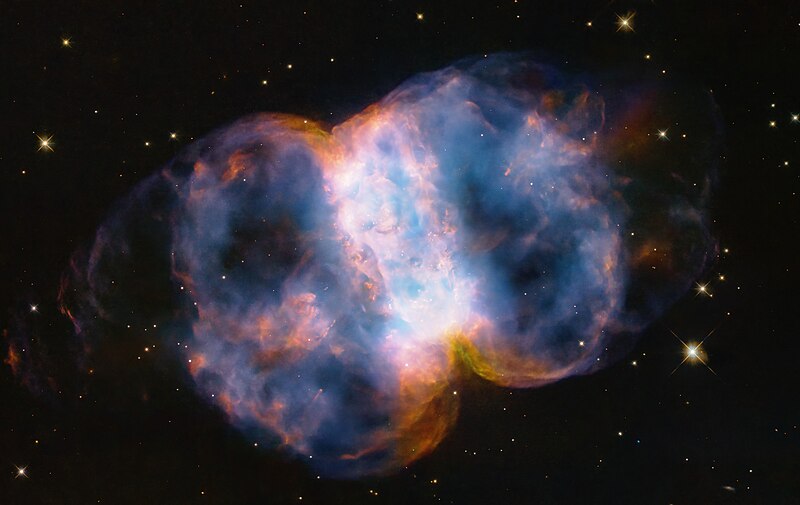ファイル:Little Dumbbell Nebula M76.jpg

このプレビューのサイズ: 800 × 505 ピクセル。 その他の解像度: 320 × 202 ピクセル | 640 × 404 ピクセル | 1,024 × 646 ピクセル | 1,280 × 808 ピクセル | 2,560 × 1,615 ピクセル | 7,505 × 4,736 ピクセル。
元のファイル (7,505 × 4,736 ピクセル、ファイルサイズ: 4.24メガバイト、MIME タイプ: image/jpeg)
ウィキメディア・コモンズのファイルページにある説明を、以下に表示します。
|
概要
| 解説Little Dumbbell Nebula M76.jpg |
English: In celebration of the 34th anniversary of the launch of the legendary NASA/ESA Hubble Space Telescope, astronomers took a snapshot of the Little Dumbbell Nebula (also known as Messier 76, M76, or NGC 650/651) located 3400 light-years away in the northern circumpolar constellation Perseus. The photogenic nebula is a favourite target of amateur astronomers. M76 is classified as a planetary nebula. This is a misnomer because it is unrelated to planets. But its round shape suggested it was a planet to astronomers who first viewed it through low-power telescopes. In reality, a planetary nebula is an expanding shell of glowing gases that were ejected from a dying red giant star. The star eventually collapses to an ultra-dense, hot white dwarf. M76 is composed of a ring, seen edge-on as the central bar structure, and two lobes on either opening of the ring. Before the star burned out, it ejected the ring of gas and dust. The ring was probably sculpted by the effects of the star that once had a binary companion star. This sloughed-off material created a thick disc of dust and gas along the plane of the companion’s orbit. The hypothetical companion star isn’t seen in the Hubble image, and so it could have been later swallowed by the central star. The disc would be forensic evidence for that stellar cannibalism. The primary star is collapsing to form a white dwarf. It is one of the hottest stellar remnants known at a scorching 120 000 degrees Celsius, 24 times our Sun’s surface temperature. The sizzling white dwarf can be seen as a pinpoint in the centre of the nebula. A star visible in projection beneath it is not part of the nebula. Pinched off by the disc, two lobes of hot gas are escaping from the top and bottom of the ‘belt’ along the star’s rotation axis that is perpendicular to the disc. They are being propelled by the hurricane-like outflow of material from the dying star, tearing across space at two million miles per hour. That’s fast enough to travel from Earth to the Moonin a little over seven minutes! This torrential ‘stellar wind’ is ploughing into cooler, slower-moving gas that was ejected at an earlier stage in the star’s life, when it was a red giant. Ferocious ultraviolet radiation from the super-hot star is causing the gases to glow. The red colour isfrom nitrogen, and blue is from oxygen. The entire nebula is a flash in the pan by cosmological timekeeping. It will vanish in about 15 000 years. [Image description: A Hubble image of the Little Dumbbell Nebula. The name comes from its shape, which is a two-lobed structure of colourful, mottled glowing gases that resemble a balloon that has been pinched around a middle waist. Like an inflating balloon, the lobes are expanding into space from a dying star seen as a white dot in the centre. Blistering ultraviolet radiation from the super-hot star is causing the gases to glow. The red colour isfrom nitrogen, and blue is from oxygen.] |
| 日付 | |
| 原典 | https://www.esa.int/Science_Exploration/Space_Science/Hubble_celebrates_34th_anniversary |
| 作者 | ESA |
ライセンス
このファイルはクリエイティブ・コモンズ 表示-継承 3.0 IGO ライセンスのもとに利用を許諾されています。
帰属: ESA/BepiColombo/MTM
- あなたは以下の条件に従う場合に限り、自由に
- 共有 – 本作品を複製、頒布、展示、実演できます。
- 再構成 – 二次的著作物を作成できます。
- あなたの従うべき条件は以下の通りです。
- 表示 – あなたは適切なクレジットを表示し、ライセンスへのリンクを提供し、変更があったらその旨を示さなければなりません。これらは合理的であればどのような方法で行っても構いませんが、許諾者があなたやあなたの利用行為を支持していると示唆するような方法は除きます。
- 継承 – もしあなたがこの作品をリミックスしたり、改変したり、加工した場合には、あなたはあなたの貢献部分を元の作品とこれと同一または互換性があるライセンスの下に頒布しなければなりません。

キャプション
Little Dumbbell Nebula M76
このファイルに描写されている項目
題材
23 4 2024
ファイルの履歴
過去の版のファイルを表示するには、その版の日時をクリックしてください。
| 日付と時刻 | サムネイル | 寸法 | 利用者 | コメント | |
|---|---|---|---|---|---|
| 現在の版 | 2024年4月24日 (水) 02:11 |  | 7,505 × 4,736 (4.24メガバイト) | Bcxfu75k | Uploaded a work by ESA from https://www.esa.int/Science_Exploration/Space_Science/Hubble_celebrates_34th_anniversary with UploadWizard |
ファイルの使用状況
以下のページがこのファイルを使用しています:
グローバルなファイル使用状況
以下に挙げる他のウィキがこの画像を使っています:
- ar.wiki.x.io での使用状況
- az.wiki.x.io での使用状況
- be-tarask.wiki.x.io での使用状況
- ca.wiki.x.io での使用状況
- ce.wiki.x.io での使用状況
- cs.wiki.x.io での使用状況
- de.wiki.x.io での使用状況
- diq.wiki.x.io での使用状況
- eu.wiki.x.io での使用状況
- fr.wiki.x.io での使用状況
- mg.wiki.x.io での使用状況
- no.wiki.x.io での使用状況
- tt.wiki.x.io での使用状況
- www.wikidata.org での使用状況
- zh-yue.wiki.x.io での使用状況
メタデータ
このファイルには、追加情報があります (おそらく、作成やデジタル化する際に使用したデジタルカメラやスキャナーが追加したものです)。
このファイルが元の状態から変更されている場合、修正されたファイルを完全に反映していない項目がある場合があります。
| 作者 | Space Telescope Science Institute Office of Public Outreach |
|---|---|
| 撮影著作権者/編集著作権者 |
|
| ソース | ESA/Hubble |
| 帰属/提供者 | NASA, ESA, STScI, A. Pagan (STScI) |
| 短いタイトル |
|
| 画像の説明 |
|
| 使用条件 |
|
| 原画像データの生成日時 | 2024年4月23日 (火) 16:00 |
| 使用ソフトウェア名 | Adobe Photoshop 25.3 (Macintosh) |
| ファイル変更日時 | 2024年4月1日 (月) 12:06 |
| デジタルデータの作成日時 | 2022年8月30日 (火) 10:10 |
| メタデータの最終更新日 | 2024年4月1日 (月) 09:12 |
| 元文書の一意なID | xmp.did:8479d9cd-83e7-418f-86e4-01c23c757277 |
| 著作権情報 | 著作権情報未設定 |
| キーワード |
|
| 連絡先情報 | outreach@stsci.edu
ESA Office, Space Telescope Science Institute, 3700 San Martin Dr Baltimore, MD, 21218 United States |
| IIMバージョン | 4 |